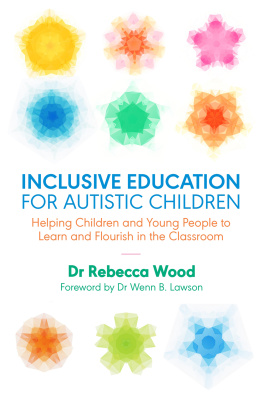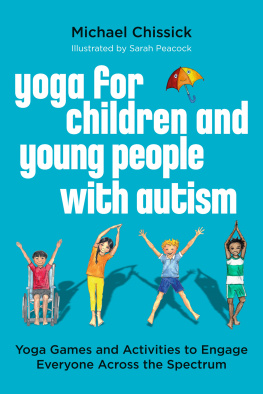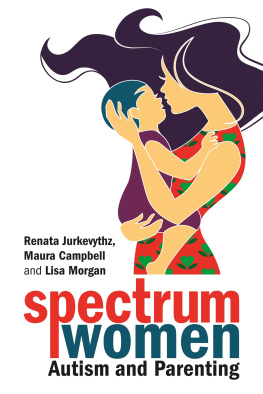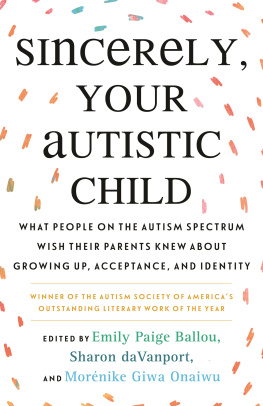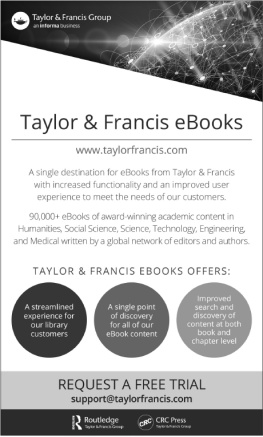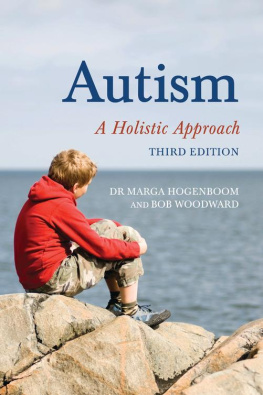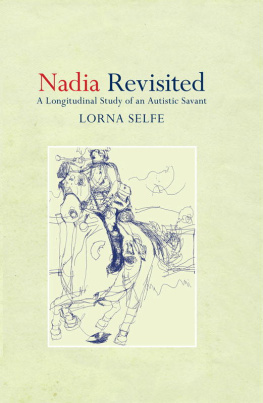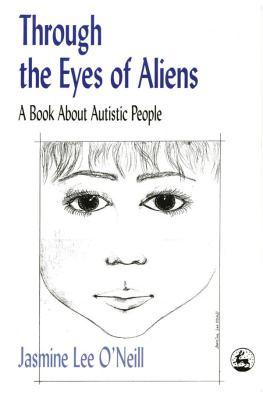
Inclusive Education
for
Autistic Children
Helping Children and Young People to
Learn and Flourish in the Classroom
Dr Rebecca Wood
Foreword by Dr Wenn B. Lawson
Illustrated by Sonny Hallett

Jessica Kingsley Publishers
London and Philadelphia
Contents
Foreword
Dr Wenn B. Lawson
As an older autistic, although still learning, I live at the other end of lifes schooling. Life always has so much to teach us, but traditional beliefs in Western Society in how we educate children have dictated that inclusion means including all, but not necessarily in the ways they need. Rebeccas book invites readers to consider the different meanings of inclusion and how it might be achieved.
A key component of this process is to listen to, observe and engage with autistic children and adults. This book, based on research involving 20 autistic people, and incorporating the views and perspectives of a further eight autistic contributors whose comments are woven throughout all of the chapters, puts the views of autistic children and adults at the centre of arguments about how to improve their educational inclusion, well-being and longer-term outcomes. These discussions are further illuminated with illustrations from the autistic artist Sonny Hallett, as well as research findings involving school staff and the parents of autistic children.
When children fail to learn, all too often we blame the child. Our focus on whats wrong or whats the problem? needs to change. As Rebecca rightly argues, by appreciating the aptitudes, characteristics and learning styles of autistic children, we not only facilitate their inclusion, but also make school life easier and more enjoyable for everyone. We must move away from seeing autism as a problem and instead, move to welcome the autistic individual with their unique strengths and abilities. Instead of looking at what we do wrong, we must explore what it is we do right. This way, when we use what works, we can apply this to areas that have posed problems in the past.
.
Being single-minded and able to focus on one thing at any one time, once interest is sparked, is a useful tool in the classroom. The importance of facilitating individual interest cannot be understated and this is discussed frequently in this book, but especially in . Its easy to think if we are only interested in certain areas, topics or subjects, this is a hindrance to exploring the bigger picture. However, research shown throughout this book depicts another story. It demonstrates (as does my own research) that interest, thought of as passion and not obsession, can be the means to accessing the bigger picture. If school and family alike will take the time to invest in who we are as autistic people, the rewards will outweigh the obstacles.
For autistic individuals, appreciating object permanence (that objects have a life of their own, even when out of sight) can also apply to people, events and emotions. So, understanding all these elements needs to be built into the art of inclusion to make school and learning accessible. For example, how do I cope with change if I have difficulties forward thinking? How can I enjoy and play a game, like Hide Go Seek if I believe once I cant see you, you are gone forever?
The difficulty is that very few schools are equipped to meet these needs, either with school layout and equipment, as echoed in .
As a younger person I lived in my baseball cap. My cap served to slightly limit my field of vision to help prevent sensory overwhelm, gave pressure to my head so I knew where I ended and helped me navigate open space. If I was made to remove my cap, my attention went with it and I became inattentive in class. Some sensory sensibilities are easily accommodated (the wearing of ear defenders, needing to work on soft or hard surfaces, going into a room first, rather than last, wearing a squeeze jacket or avoiding smelly perfumes) while other sensory differences are not so well understood. For example, Im a synesthetic and I experience colours as indicators of emotions rather than only feeling them. I certainly am a feeling person and have many different feelings, but they are possibly a bit vague and blurred around the edges. This is another reason why its important to get to know us individually, as its not one size fits all.
In addition, although we must consider sensory sensibilities, if we employ universal design as discussed at different points throughout the book we will be catering for autistic children and the whole school community. Beginning in the way we mean to go is much wiser than having to chart a new course when we discover the one we are on is not taking us where we need to go. However, it is better to adapt what we have rather than abandon ship.
Autism has traditionally been thought of as a more male disposition that occurs much less in females. We now know this is not the case. But females presenting with the same difficulties, via their female personhood, will demonstrate differing behaviours than boys and may learn to mask their difficulties. Rebecca briefly discusses some of these issues in the first and final chapters of her book, and concludes with some thought-provoking suggestions of what the future might hold, both in terms of education practice and ongoing research.
This important guide to true inclusion, which is based on several years research as well as Rebeccas practical experience in the education sector, opens our eyes to enable both teachers and families to explore ways to include, incorporate and incite cooperative relationships that foster inclusive practice. Using autistic strengths and interests to build bridges across the areas outlined above, and echoed within this text, are vital to creating true inclusion at school.
The Contributors
Grace
Grace is 14 years old and loves to draw. She adores her cats and has many friends at school but only a few best friends and spends lots of time with them. Grace enjoys ICT and art at school but doesnt really like the other subjects very much. She likes watching anime and reading manga, and Attack on Titan is her favourite. She is an animal lover and is very passionate about the conservation of wildlife, particularly big cats, and hopes to help protect them by donating to charities. Grace is quiet and shy but thinks shes a good friend.
James
James is 8 years old and lives with his mum, dad, older brother and two dogs. He loves Wikipedia and learning facts about everything so he can tell people them. His favourite pastime is history: at the moment this is movie history of the 1930s and 1940s. James finds it hard to tell people how he is feeling, and this makes him anxious. But his friends say he is always the first to help if they are sad or hurt, and he is great to be around, especially when he is excited about something. James is very proud of himself.
Rose
Rose is 8 years old. She has long, blonde hair and likes to play with her friends. Rose is exciting and funny and loves going wild with her friends. She is clever and smart and does her work whenever she is asked to. Rose only likes a few foods. She likes YouTube, Roblox, Minecraft and Glitter Force on Netflix. Rose enjoys Christmas because of the presents, Halloween because she likes dressing up as a scary person, and Easter because finding the eggs is like a treasure hunt.
Zack
Zack is 10 years old and lives with his mum, dad and three siblings. He loves making breakfast for his youngest sister. Zack really enjoys playing on his Xbox: his favourite games are WWE 2K17, Sunset Overdrive and Overdrive by Titan. He really likes going to the park to play on the gym equipment, going out with his mum and borrowing audiobooks from the library to listen to at home. Zacks favourite foods are pepperoni pizza, cheese toasties and macaroni cheese. As a treat, he sometimes goes out with his mum for a cheese toastie. Zack doesnt really like school he finds it hard.
Next page
